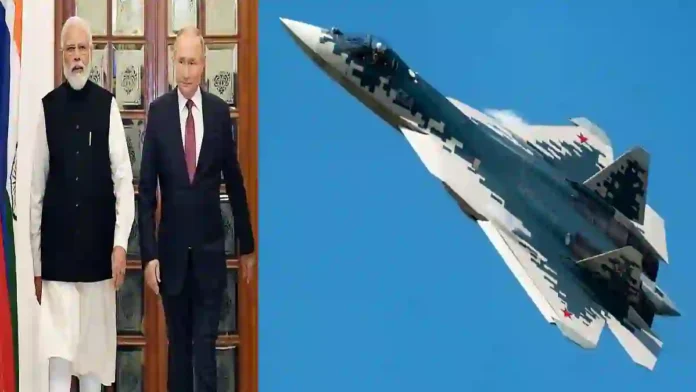Russian President Vladimir Putin’s highly anticipated visit to India in 2025 is expected to be a pivotal moment for strengthening Indo-Russian defence relations, with a central focus on a comprehensive Su-57 fifth-generation stealth fighter jet deal. This initiative represents a strategic shift in India’s defence procurement policy, especially amid India’s rejection of the U.S. F-35 offer over concerns about cost, technology transfer, and interoperability with existing Russian-origin defence systems.
Russia’s proposal to India includes the immediate delivery of 20 to 30 Su-57 jets along with full technology transfer and co-production rights at Hindustan Aeronautics Limited’s (HAL) Nashik facility, aligning with India’s “Make in India” initiative.
Read- IAF Chief confirms 5 Pak Jets, 1 AW&C shot down by S-400 during Op Sindoor- AP Singh
India would also gain access to the Su-57’s source code, enabling integration with indigenous systems such as the Astra air-to-air missile and Virupaksha AESA radar, thereby enhancing operational autonomy. The proposal further suggests an interim supply of advanced Su-35M fighter jets to address the Indian Air Force’s (IAF) current squadron deficit, which stands at 31 squadrons compared to the sanctioned 42.
The Su-57 offer represents not just a sale of aircraft but a comprehensive partnership involving joint production, technology sharing, and potential future collaborations in advanced air defence systems. Discussions may also extend to the co-development of the more advanced S-500 air defence system and upgrades to the indigenous Akash missile system, reflecting a broadening of bilateral defence ties.
Beyond aircraft, the proposal includes support for India’s indigenous Advanced Medium Combat Aircraft (AMCA) program, which is still in developmental stages and expected to take another decade to mature fully.
Strategically, the deal is expected to strengthen India’s position in the region by enabling technological and operational synergies to counterbalance regional threats from China and Pakistan, both of whom are advancing their own fifth-generation fighter capabilities.
The Russian offer comes at a time when Western defence ties face strain due to trade tensions and India’s insistence on technology transfer and self-reliance, which the U.S. F-35 deal failed to meet adequately. Thus, the Su-57 deal is seen as aligning with India’s broader goal of defence self-sufficiency and indigenous capability enhancement.
Read- After Op Sindoor Success, Army Moves To Boost Drone Defence Network
Read- Defence Ministry Rejects Reports of India Halting US Arms Talks, Calls Them ‘False & Fabricated’
Despite the promise, challenges remain. India continues to develop the AMCA as a long-term indigenous solution, and historical concerns regarding the Su-57’s stealth features and cost-effectiveness—issues that led India to withdraw from an earlier joint development effort in 2018—might temper enthusiasm. However, the immediate need to replenish the IAF’s fighter jet squadrons amid shifting geopolitical realities lends urgency to Russia’s offer.
Putin’s visit is therefore expected to finalise not only the Su-57 fighter jet agreement but also open doors for new defence collaborations, potentially including expanded joint development of air defence systems, future Indian defence exports to Russia, and broader strategic cooperation that reinforces their longstanding partnership.
The 2025 Russia-India defence agenda under Putin’s visit is poised to deepen ties by potentially securing a landmark agreement for the Su-57 fifth-generation fighter jets, supporting India’s defence modernisation with technology transfer and local production, while enhancing strategic autonomy in a complex geopolitical environment.
IDN (With Agency Inputs)
Agency




